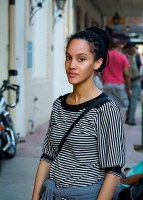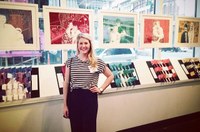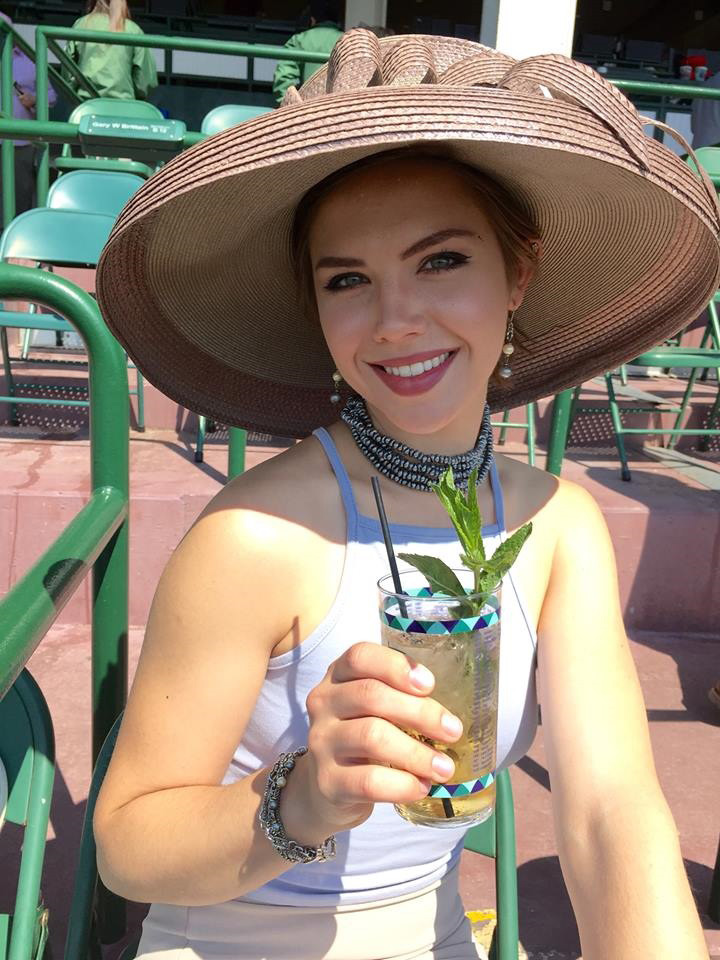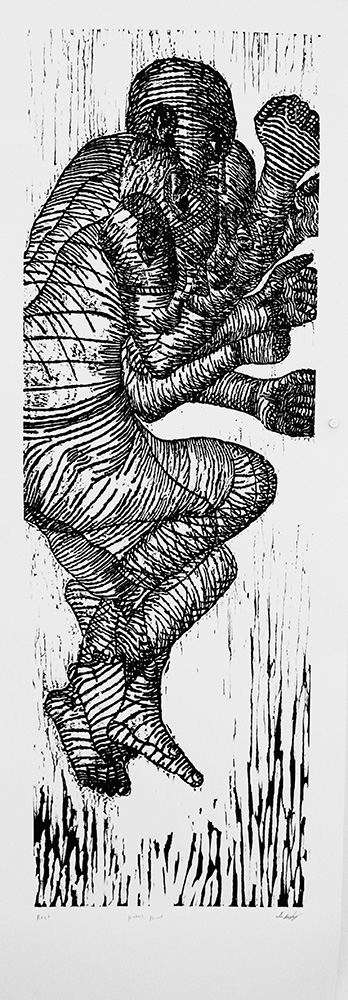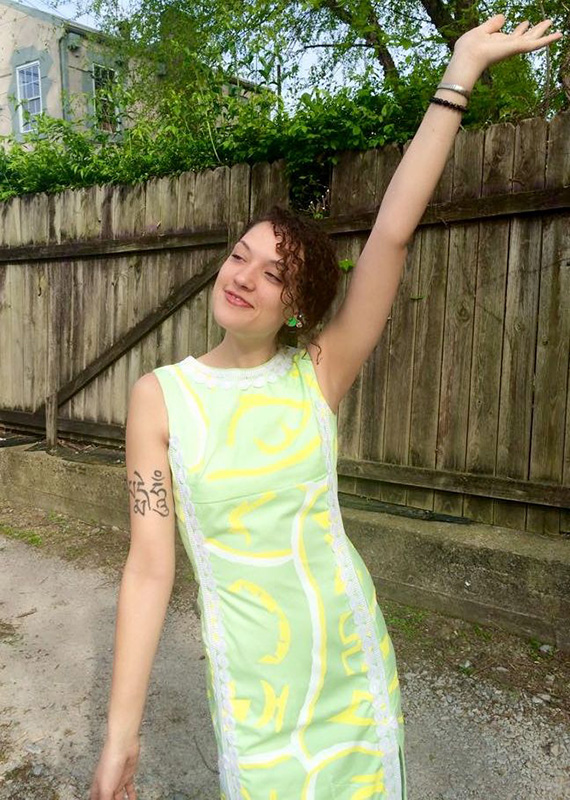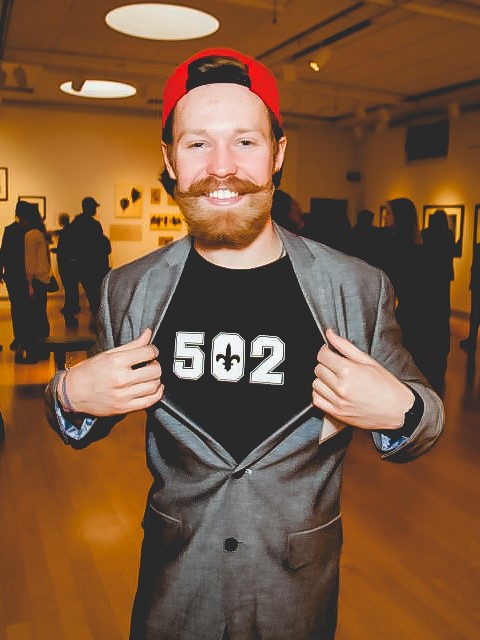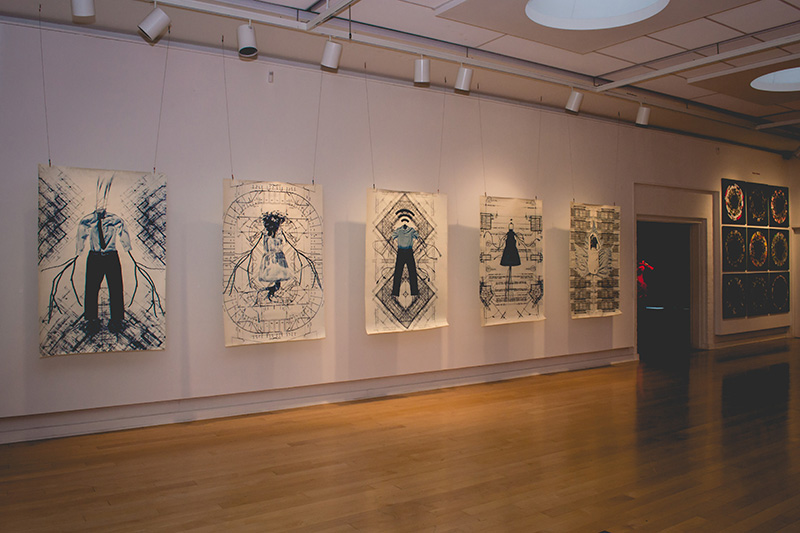Spring 2015 BFA Thesis Exhibitions
The show at Schneider Hall Galleries will feature the artwork of William Beasley, Katlyn Brumfield, Tess Lindsey, Whitney Olsen, Renae Osman, Sasha Perez, Sarah Reasor, Allison Reynold, Luke Seward, Carolyn Spears, Shelby Stafford, Ashli State and Kevin Warth.
The show at the Cressman Center will feature the artwork of Taylor Beisler Coomer, Julia Burton, Jake Ford, Eric Francke, Elizabeth Heustis, Elizabeth Middendorf, Caitlin Morton, Devon Murphy, SaraBeth Post, Amber Schultz, Rachel Stottmann, and Sam Tunget.
Each BFA candidate will contribute their unique vision as represented by a concentrated body of work developed to demonstrate their readiness to enter the professional art world upon graduation.
Renae Osman
Tell me about your exhibit and your work.
My body of work in the BFA exhibition is titled Voids, and contains nine 30 inch x 30 inch photographs in a grid presentation. I construct unrealistic spaces using digital montage of scanned and photographed objects that represent consumer culture, incorporating familiar items to explore the unconscious desire for meaning and purpose in life. My work questions the true sense of fulfillment that society's indulgences are thought to bring.
Did you have a key mentor or professor?
Tell me about that person and how they influenced you. Professor Mitch Eckert was my mentor. Not only did he influence my work greatly by introducing me to the art of scanography and digital construction, but he was there to provide inspiration and insight into the ways I could improve my work and grow artistically over time.
What are your plans after graduation?
To pursue a career in commercial photography and photo-editing, as well as continue creating art for gallery exhibitions.
Sasha Perez
Tell me about your exhibit and your work.
My photo series Seven Deadly Bedrooms explores how people conceal their vices behind closed doors, breaking the barrier between what we reveal to the public and what we keep in secrecy. My photos were printed as Duratrans (large format color transparency material) and backlit inside hand-made light boxes. Each light box has doors on the outside allowing the viewer to open and peer into the rooms through a peephole window as voyeurism is crucial to my concept.
The exhibition experience itself was incredible and went smoothly. It was an unforgettably positive experience for me and I'm still reeling over how well everyone responded to my work.
Did you have a key mentor or professor? Tell me about that person and how they influenced you.
Mary Carothers and Mitch Eckert were both mentors; however, I worked more closely with Mary in putting together this exhibition. Mary's input was very constructive to my final work. She helped me in deciding how to present my pieces and pulled out helpful tips and ideas when I was uncertain of something. Mitch was very detail-oriented, so his input helped me fine tune my work. Yasmeen Siddiqui, the gallery curator, was incredibly helpful when it came time to decide where I wanted to display my work. She helped me choose a space and arrangement for my pieces that worked perfectly.
What are your plans after graduation?
As of now things are still very general and not fully planned out. I'd like to find an art-related job and continue submitting to local and national galleries while I produce work on the side to build up my portfolio.
Taylor Beisler
Tell me about your exhibit and your work.
My exhibit deals with the depth of humanity. I create pictures from true stories of people from my imagination in order to empathize with their vulnerable moments, which I believe we all have. In this day and age, it's easy to opt out of face-to-face communication, but I think we lose depth when we do that. I hope, from viewing my work, people will be more curious as to the depth within the person next to them.
Did you have a key mentor or professor? Tell me about that person and how they influenced you.
I have the sincerest respect for Professor James Grubola for his long-suffering advice and incredible generosity of time and resources. I have picked his brain so many times, and I have always been able to gain a better understanding of what I am doing as an artist. I will always remember my first critique from him because it still teaches me every day to “challenge” myself because he was right—I do have more in me. He is an invaluable resource to me. Thank you for everything.
What are your plans after graduation?
I want to travel, pick up conceptual and possibly engineering work, and go to graduate school in order to teach.
Devon Murphy
Tell me about your exhibit and your work.
Working in both drawing and painting, I record and layer the interactions I have with my sitters. I have always been very interested in social interaction and how those connections are formed, especially as a sufferer of Generalized Anxiety Disorder, which makes human connection a bit harder to achieve. Using layers of thin acrylic paint, I slowly create a composite of the features and gestures of the person sitting before me. Through careful observation I hope to reveal those movements and expressions intrinsic to each person and the specific situation they are in.
Did you have a key mentor or professor? Tell me about that person and how they influenced you.
Over my time at the Hite Art Institute, I came into contact with a variety of wonderful and patient professors, who I believe each taught me something vital. My first foray into painting came from Prof. Mark Priest's intro class. I don't believe I've ever learned more about painting anywhere else than that class. Prof. Priest certainly helped shape my painting skills and continued to assist me.
Professors Sharon Leightty and Jim Grubola also provided me with important drawing skills, and their critiques made me more adept at critically evaluating my work, while also bettering my ability to view the art of others. On more than one occasion their critiques made me think, or added something to my understanding of art and drawing. And lastly is Professor Gabrielle Mayer, who has worked with me since I entered the first intermediate class. Prof. Mayer assisted me with professional practice, helped me explore a variety of materials and mediums, opened me up to a lot of artists, and was just generally a good resource for any question I had about painting, philosophy, or research. These great people continue to assist me today.
What are your plans after graduation?
Currently I work at both the Kentucky Science Center and REACH Tutoring Services, so I wish to continue my work to develop a resume for further careers in museums. I am also continuing to make more paintings and drawings to beef up my application to graduate school for studio art and museum studies.
Kevin Warth
Tell me about your exhibit and your work.
In my work, I photograph BDSM practitioners in the language of family portraiture and engage with issues of LGBTQ politics, family, and domestic space. The resulting pictures are often humorous and play with a space that is, for many viewers, both familiar and unfamiliar. I comment on the gay marriage movement and ask an imperative question: how can queer individuals envisage the concept of family when it has become synonymous with marriage?
The exhibition shows two distinct subject matters from this body of work – still lives and portraits. The still lives depict everyday scenes from an American household, but integrate bondage gear as it is hung up, discarded, or cleaned. My portraiture uses conventional poses, expressions, and locations to depict members of the BDSM community. For these, I utilized the salon style and store-bought frames to reference the portrait wall that is common in many homes.
Did you have a key mentor or professor? Tell me about that person and how they influenced you.
I am lucky to have a group of amazing professors, without whom I would not be where I am today. Mitch Eckert and Mary Carothers are my photography professors and mentors – they have been there since this project's infancy and were crucial in helping me to evolve my work. Prof. Jongwoo Kim also played a big role as I worked towards this exhibition. He aided me in developing the theoretical backbone to my work as well as refining it. Finally, I have to recognize our gallery director, Yasmeen Siddiqui, who both provided great insight on my work and helped me devise the final installation plan.
What are your plans after graduation?
I will be attending graduate school, hopefully getting my MFA in Studio Art and my MA in Art History. I would love to teach in either area afterwards. Regardless, I will continue creating work and writing as these are my two biggest passions.
Elizabeth Middendorf
Tell me about your exhibit and your work.
There are influential people who surround me every day, but the most influential and most important is my own mother. A mother is defined as a woman in relation to a child, to whom she has given birth and brings up with affection. The bond between mother and child is an important experience that impacts our lives. My work focuses on my relationship with my mother from my birth to present day. The series consist of prints and artist books with a focus on screen and digital printmaking.
Did you have a key mentor or professor? Tell me about that person and how they influenced you.
I have had two mentors during my time at University of Louisville, Prof. John Whitesell and Prof. Barbara Hanger. Professor Whitesell influenced me by teaching me the skills and techniques of printmaking. Prof. Hanger has encouraged me to take my ideas to the next level with artist books.
What are your plans after graduation?
I plan on pursuing a career in art and design in the greater Cincinnati area.
Samuel Tunget
Tell me about your exhibit and your work.
My work is driven by the process of how we draw and displaying that on the paper. Because of this idea, I use the paper as a means to display figure drawing, with the addition of how ideas change and composition begins to form.
Did you have a key mentor or professor? Tell me about that person and how they influenced you.
James Grubola was my key mentor for my work and exhibition. Like any good mentor, he engaged my ideas thoroughly and gave me invaluable advice to help see my art through.
What are your plans after graduation?
I plan to travel internationally for some time, taking the opportunity to broaden my horizons before applying to graduate school.
Tess Lindsey
Tell me about your exhibit and your work.
My work in the BFA exhibition is a group of painted portraits that explore the ways in which humans are interconnected. I started by interviewing people about the human commonalities that they perceived and then worked closely with them to create a portrait that communicated their ideas.
Did you have a key mentor or professor? Tell me about that person and how they influenced you.
My mentor has been Gabrielle Mayer, who has been instrumental in pushing me to improve my technique. She has high expectations for painting and concepts. She has helped me to constantly think of my work in a critical manner that allows me to problem solve and improve.
What are your plans after graduation?
After I graduate I will continue to paint independently to figure out exactly what I want to achieve with the medium. I will be selling hand-bound books to supplement my income until I apply to an MFA program for painting.
Whitney Olsen
Tell me about your exhibit and your work.
My exhibit is called Ethereal study #3. I wanted to create an experience that mimicked the fleeting and ephemeral qualities of life. In my opinion, change makes people feel the most present or the most "alive.” In my work, the suspended glass spins with the energy in the room and reflects projected light throughout the space. The oscillating refractions expand and contract as well as morph into one another on the opposite wall. Light was one of the most important elements of the work because, for me, it is a fundamental metaphor for life. It is a basic form of energy that allows us to visualize the world, yet it can also distort the way we see the world. The "portals of perception" obliterate the walls, and the room expands beyond physicality. This work questions the space between the tangible and the intangible.
Did you have a key mentor or professor? Tell me about that person and how they influenced you.
I took sculpture as my major class for two years before I even discovered glass as a medium, therefore I have two mentors because I couldn't choose one over the other. They both are truly the best but are complete and total opposites. Prof. Scott Massey is the sculpture department head and was my mentor for several years. He has really allowed me to search within myself in order to figure out what my work was. His critiques are brutal but they build you up and make you fight for what you want. Prof. Che Rhodes has been my mentor for quite a while, too. In his class we had to work very hard. Glass doesn't work for everyone because it is so frustrating, it has a mind of its own. Che played a big role when it comes to what I wanted to say. He made me realize that if you are smart and work hard than you can do anything. Both of these instructors are amazing I wouldn't be where I am without them. I was really lucky to have them as mentors.
What are your plans after graduation?
After I graduate I plan on going to Bikram yoga training to become a certified yoga instructor. This practice keeps my mind and body balanced and I want to be able to take it with me wherever I go. I plan on going to Penland School of Crafts over the summer, which I am super excited for! I would like to take as many classes and learn as many things as I can while out of school. There are always opportunities for people that want to work hard. I have a current project that I started this semester and my goal is to finish that over the summer. I would like to find a gallery in town that would like to show it and hopefully my thesis work as well. I also need to make a website and "professionalize" my portfolio, and be an adult and figure my life out, but the main goal is to keep working so that I can attend grad school within the next two years.
William Beasley
Tell me about your exhibit and your work.
I am a printmaker who works mostly through woodcut and other relief print media. My work is primarily focused on the juxtaposition of two-dimensionality and moving figural subjects, which creates a commentary about the nature of abstraction. This juxtaposition is due to the intentional stability of the wood block, the fleeting nature of clarity, and the illusion of stagnation.
Did you have a key mentor or professor? Tell me about that person and how they influenced you.
My key professors would definitely be John Whitesell and Barbara Hanger.
Prof. Whitesell was my official undergraduate mentor. He guided me through many tough stylistic and conceptual challenges through my undergraduate career, which allowed me to develop my craft to the level that I feel confident in continuing outside of an academic setting.
Prof. Hanger gave me the opportunity to be her undergraduate assistant over the last year in her Intro to Printmaking course, which gave me the opportunity to learn a lot for myself as well as teach others. I have become a much more skilled printer and craftsman because of that experience.
I can't thank them both enough.
What are your plans after graduation?
I would like to take a few years, and just show my work and complete residencies before I pursue an MFA. I have been offered a job at a silkscreen printing shop in my hometown now that I've graduated, which I'm eager to begin. I have also generated some interest in showing some of my work at a Louisville-based gallery after the university show comes down, which is always an exciting opportunity.
All in all, I am optimistic and excited for the future.
SaraBeth Post
Tell me about your exhibit and your work.
The concept of my exhibition revolves around an investigation of one's relationship between logic and intuition. I am interested in the immediacy of what one learns through the physical world, and the continuation of what one may learn or discover after allowing their thoughts to be superimposed upon their immediate visual perception. The known vs. the unknown, or the tangible vs. the intangible are fascinating question generators.
I create flat glass panels through fusing individual pulled canes, and slump the flat panels over plaster-silica molds. This process allows the glass to obscure the visual qualities of the original positive form.
Did you have a key mentor or professor? Tell me about that person and how they influenced you.
Prof. Ché Rhodes was my mentor and someone I have worked with for four years. He helped me more than anyone to understand that putting concept and content first, and truly understanding what I want to say or communicate through my work, will generate a better work of art. I am beyond grateful for his guidance.
I can't thank them both enough.
What are your plans after graduation?
After graduation I am immediately going to the Pilchuck Glass School in Washington to work as a Cold Shop Assistant for two sessions. Then, I will travel to the Corning Museum of Glass Studio for a two-week workshop. After making new work, applying for residencies, and assistant positions, I plan to apply to graduate school, and become a professional artist and teacher.
Luke Seward
Tell me about your exhibit and your work.
My BFA work, titled Mapps, explores our relationship with technology relative to the world around us. Many aspects of technology enhance the quality of our lives, while others can be distracting. I suspect our relationship with technology is suspended somewhere between convenience and disruption. This body of work explores the role technology plays in our lives, and questions whether constant connectivity is leading to a deeper disconnect. By depicting the idea of a nuclear family in combination with architectural blueprints, I reference the idea of home and where we find comfort. Are virtual spaces providing the same level of comfort we feel at home?
Did you have a key mentor or professor? Tell me about that person and how they influenced you.
Mary Carothers and Mitch Eckert have been extremely impactful mentors. These professors truly challenge students to nail concepts, push processes, and ultimately produce quality bodies of work. Both Mitch and Mary have been an inspiration in my life and I cannot thank them enough for the experience they have provided to me in my undergraduate career.
What are your plans after graduation?
I am taking a year off to explore anthotypes – images created using photosensitive material from plants – before applying to graduate school. My goal is to be accepted into an MFA program starting in the fall of 2016.

